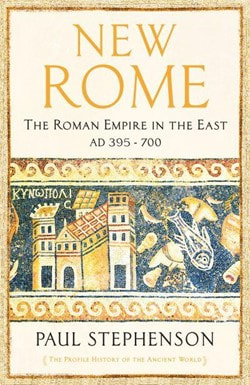|
“History means thinking into other people’s minds,” according to N. T. Wright (Paul: A Biography, 8-9). This is one reason I value histories that use, as primary sources, poems and other literary works contemporaneous with the events being described, as well as diaries and letters. It’s true that the poet’s mind comes to us filtered by poetic technique and literary convention (this is also true of other forms of writing); but we always encounter the minds of historical figures in written works that necessarily reflect their culture’s intellectual and expressive conventions. We are no different: even the avant-garde has its own rhetorical conventions and toolkit of transgressive (unmannerly) manners.
In this little essay I’ll discuss briefly two works: (1) Paul Stephenson’s New Rome: The Empire in the East (Belknap Harvard, 2021), a book chosen by the Times of London as one of the best history books of 2022, and (2) Martin Gilbert’s The First World War: A Complete History (Holt, 1994), a book I first read when I was preparing to teach the literature of World War 1 at Southern Virginia University in 2016. I have not yet begun to read Stephenson’s work—I received it for Christmas—but, wondering if he drew on the Greek Anthology as a source, I checked the index. The anthology is a rich collection of Greek poems, mostly epigrams, from the earliest poets through the Byzantine era. According to Wikipedia, “the Greek tradition of epigrams began as poems inscribed on votive offerings at sanctuaries – including statues of athletes – and on funerary monuments.” Often epigrams that were written only to be shared on paper made a pretense of being epigrams—poetic inscriptions—in the original sense. To my delight, Stephenson does make use of the anthology and other Greek poems. Among the sources used by Stephenson are inscriptions to charioteers who raced in the hippodrome. The Greek Anthology has fifty-four such epigrams, “each copied down from a charioteer’s statue base in the hippodrome” (73). Poems are sometimes a key source for an emperor’s reign; in the case of Justin II, key sources are a long narrative poem by Corippus and a cycle of epigrams written by Agathias and included in the Greek Anthology. In some cases (for example, the reign of Theodosius), scant poetry remains, though the emperor’s court at the time was renowned for the outpouring of literary works. Another poet that Stephenson mentions by name is Paul the Silentiary, a friend of Agathias. Silentiaries were “court officials of privileged backgrounds,” according to Wikipedia, “whose first duty was maintaining order and silence in the Great Palace of Constantinople.” I’ve always found this somewhat amusing, but I suppose we would describe the 30 silentiaries as Secret Service agents or security staff, distinctively less amusing. It was a prestigious post; the officers were assigned “important commissions, especially in church matters,” and belonged to the highest social rank in the empire. An indication of Paul’s importance was the speech he was invited to give at the rededication of the Hagia Sophia (215), a speech characterized by its “complex imagery” (350). Stephenson cites lines from Paul’s description of an imperial villa: “The sea washes the abode of the earth, and the navigable expanse of the dry land blooms with marine groves. How skilled was he who mingled the deep with the land, the seaweed with gardens, the floods of the Nereids with the streams of the Naiads” (118). This brief summary hardly exhausts Stephenson’s use of poetry to depict the events, monuments, rulers, and ideologies of Byzantium, but it indicates how poems can be used in historical works to conjure a sense of the past and to enter at least partway into the minds of those who lived then. Perhaps a more accessible use of poems to enliven and instruct the study of history is Martin Gilbert’s one-volume history for the First World War. Gilbert's use of poems is not surprising. A bibliography compiled by Catherine Reilly lists "2,225 British writers who experienced the war and published poems about it” (The Winter of the World; see below). More than thirty anthologies were published in Great Britain during the war years, most of the poems by forgotten writers. But many are well known in Great Britain and elsewhere. A contemporary anthology that I highly recommend is The Winter of the World: Poems of the Great War (Little, Brown, 2007), edited by Dominic Hibberd and John Onions. Gilbert places the poems in two contexts—the campaigns and battles that evoked them and the experiences of the poets who wrote them. The history and the poems illuminate each other. The poems have many styles and points of view, but the best known arguably belong to the late Romantic era and seem to speak directly to the common reader, however skillfully crafted they may be, however consciously embedded in the poetic tradition. For readers 2000 years from now, if there be any, the conventions will loom as artificial barriers between them and the experiences that animated the poets. Some readers already feel that way. As in the Greek Anthology, a number of the poems are inscriptions on monuments, but most are standalone poems, sometimes the soldier’s only surviving poem. Gilbert’s account of the death of Wilfred Owen is perhaps representative of his approach: “In the British assault on the Sambre Canal on November 4 [just a week before the Armistice], an attempt by engineers to throw a temporary bridge over the canal was prevented by heavy German artillery and machine-gun fire. Almost all the engineers were wounded, and the canal was unbridged. The poet Wilfred Owen was seen encouraging his men to try to get across on rafts. 'Well done!' and 'You are doing well, my boy,' an officer in his company recalled him saying. The rafts proved unsuccessful, however, so planks and duckboards were put together. At the water's edge, helping his men in this task, Owen was hit and killed. ... At the place where Owen was killed, near the village of Ors, the canal remained unbridged. His battalion eventually crossed on an existing bridge a few miles lower down. On his tombstone in the village of Ors are inscribed the words of one of his poems: Shall life renew These bodies? Of a truth All death will he annul. In the original poem, the second sentence also ended with a question mark.” (492) As to why Gilbert uses poetry so often, perhaps his concluding lines explain: “All wars end up being reduced to statistics, strategies, debates about their origins and results. These debates about war are important, but not more important than the human story of those who fought in them.” (Kindle edition, 543)
0 Comments
 A bowl of sycamore wood Mouth Work was my third book of poetry. Winner of the Lena Shull Award from the North Carolina Poetry Society, it was published by St Andrews University Press in 2016. The book is dedicated to three young men, brothers, that my wife and I befriended when they arrived in North Carolina from the refugee camp in Rwanda where they grew up. Recently we flew to Rwanda to attend the wedding of the youngest brother, a wonderful trip that set me to thinking again about one of my favorite poems in Mouth Work, or anywhere else, titled simply “A Song.” It’s a poem where the young men play a brief but key role.
Famous poets have no need to explicate their own work—others will do it for them—but an audience exists if they care to do so. As to us who are unknown, no one will do it for us: if there is no audience for the poem, there is certainly none for the explication. For the poet to do it is a vain endeavor in both senses of the word vain, and yet for this poem it seems, to me, worthwhile to do, if only to revisit the poem and breathe again its clear air. It's quite likely that my understanding of the poem is now shaped by my recent reading in Iain McGilchrist’s The Master and His Emissary. The world we live in is increasingly virtual, he writes, that is, it is increasingly “mechanistic, fragmented, [and] decontextualized.” It is a “self-reflexive … world,” a “hall of mirrors” with the exits blocked. A Song A poem for the sycamore, a sycamore for the snake that swims in the shallows sheltered by its roots, roots for the land, to hold it in place, land for the sycamore, on whose long thick limb we’ve lain cantilevered over the river in shade, shade as blue as a jay’s feathers and free to all comers. * * * A poem for board feet standing in a mane of leaves fluttered by air of their own making, air for poet and spouse, poet and spouse for each other and land and snake and river and sycamore, sycamore for the leaves, leaves for the air, air for the song of marriage we are singing. * * * Those who venture off trail-- booted against snakes, whistling Colonel Bogey’s March, surveyor’s maps rolled underarm-- see dimity patterns the roots make on ground checkered with shadow and light, and with every step are wary: clutters of leaves may strike, the stepped-on stick bite back. * * * Those tongues flicker to find us out, warm-blooded calculators who fell and bark, slab and mill through knot and burl till the tree of knowledge is pollarded and bare, a lacquered coat rack where perch the birds of abstraction. * * * This sycamore rising dog-legged-- or is it a god’s leg, or that of a god’s horse straining the wooden musculature to rear against the bit?-- is hard to fix in words that do not hobble the power, but when saw and dozer cut their buck and wing, easy to reckon the board feet. * * * By this border of blooming surveyor’s flags in weeks we’ll step arm in arm then do-si-do over hardwood; on a bed as wide as a pond glimpse in our dreams afternoons that stretched a heron’s wing over the river in woods whose high crowns for us have been lopped and pulped * * * and made into this paper on whose void the words elusive as a swarm of gnats reeling and spinning bless our reading chair, our table where a boy not long from Africa types the home row letters: lads fall; all sad lads; half sad half glad: all fall; * * * bless the safe place we have made, the wooden bowl on the table, the fruit that fills it, the gnats eating the ripe fruit, the fruit of prayer and meditation; and bless the headboard in whose shadow we dream the tree whose fruit we are—logger, surveyor, poet and spouse, lads: same tree, same fruit. I began the poem many years ago, in the first class I took from Ann Garbett’s continuing education poetry class at Duke University. The first finished version was rather moralistic, and as such was strongly criticized by a group member. So it went back into the slush pile, was pulled out from time to time, revised, then thrown back as still unsatisfactory. At some point I hit on the device of anadiplosis to enact verbally the interchanges and trade-offs in life that constitute the theme of the poem. In anadiplosis, the words at the end of a phrase or clause are repeated at the beginning of the next: “A poem for the sycamore, / a sycamore for the snake.” “A Song” has 16 five-line stanzas, divided into eight two-stanza sections. Anadiplosis figures most in the first two sections: “sycamore for the leaves / leaves for the air, air for the song / of marriage….” The device is used to emphasize the interplay of energies and gifts: “roots / for the land, to hold it in place, // land for the sycamore.” The roots of the sycamore hold the riverbank in place, and earth is what the sycamore needs to put down roots. One thematic thread begins in the 1st section, with a water snake swimming in the shallow pool created by the sycamore’s roots; later, snakes are concealed in the woods amid the roots running along the ground, and further hidden by fallen leaves and the checkered light filtered through the foliage. The reader may be reminded of Moses’s staff that turned to a snake in the court of the Pharoah (3rd section). In the next section, the camouflaged snakes size up the booted surveyors wandering with their maps into the snakes’ mysterious, dangerous domain. The abstracting, calculating, geometric science of the surveyors turns the tree of knowledge in Genesis into a “pollarded and bare /… coat rack,” an abstraction of a tree shorn of leaves and unable to generate the air we breathe (4th section). This theme is repeated in the next section with different imagery—the muscled trunk of the sycamore suggests a god’s or at least a horse’s powerful leg, a presence of the living tree that one can only evoke but not explain; it is far easier to articulate the commodity value of trees considered as board feet. Back in the 2nd section, the mysterious, unifying interchanges among leaves, air, land, snake, and tree evoke the mystery of the married couple singing a song they did not know until that moment. In the next section, a couple “step arm in arm” past the surveyor’s flags into their home, onto their bed “as wide as a pond.” And what do they dream about? The woods before they were cleared for their homesite. In the original version, which was far different in many ways, it was at about this point, then almost at the end of the poem, that the member of the critique protested. I believe the gist of his critique is that people must live somewhere; a poem that does not understand that is empty moralizing. I have since tried hard to avoid the simplicities of ideological judgments. After rumination of several years, and after becoming happily involved with the young men from Africa, I understood that a way of life has costs, but it has also benefits. The trees that are “lopped and pulped” at the end of the 6th section become paper in the next; and on this paper a young man from Africa prints words he has typed on a computer as he masters his keyboarding skills (he was using Mavis Beacon Teaches Typing). The lesson begins with the plaintive messages he can find on the home row, the letters ASDF and JKL where the typist’s fingers rest, plus the letters G and H. The fallen trees give the table the young man works at, the wooden bowl and the apples that fill it, the married couple’s headboard. They dream about the tree of life to which we all belong. Comments or suggestions? Email me at [email protected] |
AuthorWrite something about yourself. No need to be fancy, just an overview. Archives
July 2024
Categories |


 RSS Feed
RSS Feed